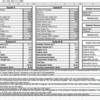quote:
Originally posted by greg's 66:
... I didn't realize that the max lift points weren't on the center line. What would the effect be of moving the max lift points? How would that effect the cylinder pressure and performance ...
The "max lift" points cannot be aligned with the camshaft centerline. The camshaft lobes are designed and ground asymmetric. They open faster than they close. These are desirable features.
Its is desirable to open both the intake and exhaust valves as early as possible. A piston descending on the intake stroke reaches maximum velocity at about 70° ATDC, yet the intake valve is not fully open until about 105° to 110° ATDC ... its about 35° to 40° behind the program. In fact the piston begins decelerating at about 110° ATDC, just 5° or less beyond maximum valve opening! The wider we can open the intake valves by 70° ATDC the better. Similarly the majority of exhaust gases MUST be expelled by the time the piston's dwell period at BDC is over (30° ABDC), yet the exhaust valve is not fully open until about 65° ABDC. Again it is about 35° behind the program. The more exhaust gases remaining in the cylinder after the dwell period, the harder the engine must work to push them out, this impacts the engine's power output. The wider we can open the exhaust valves by 30° ABDC the better.
It doesn't harm a valve to lift it off of its seat quickly, but setting it back down on its seat quickly can cause valve bounce and/or accelerated wear and damage. Here again, an asymmetric lobe which closes the valve more slowly is an advantage.
Cylinder pressure (aka dynamic compression) is impacted by the point at which the intake valve closes. Street engines generally close the intake valve earlier, around 70° ABDC, to avoid low rpm reversion. Advancing the camshaft, thus closing the intake valve earlier, would increase dynamic compression. Asymmetric lobes do not affect the timing of the seated valve events.
quote:
Originally posted by greg's 66:
... do you have any way to estimate the power difference between a good 2v iron head and what my heads would make? ... one car with this cam in it has ported 2v heads, and a fantastic fuel injection system built on a webber 4x2 intake and a bundle of snakes exhaust ... Another car ... 2v heads and weiand X-cellerator intake with a 750 holley ...
No, not really. "Knowingly" ported 2V heads are capable of supporting about 500 BHP with a single 4 barrel carburetor. That means they're flowing about 250 cfm at 0.400" lift. I've never messed with an engine equipped with the CHI 185cc heads. Those came along decades after my time. The CHI heads have higher intake ports than a 2V head or even a 4V head. So although the ports are small they should flow more air than a 2V head. The CHI heads should also have better combustion chambers which is very important but often overlooked by enthusiasts.
In your examples the iron 2V heads were combined with the better induction and exhaust systems, whereas the CHI heads were combined with more "run-of-the-mill" induction and exhaust systems. The iron heads were being utilized to their max, the CHI heads were not.
quote:
Originally posted by greg's 66:
... do you think the Crane cam will pull to 6000rpm? Or do you think I should go custom?
Yes, timed as I have suggested, and combined with your exhaust system and the 750 carb you plan on using, the Crane cam will allow your car's engine to pull to 6500 rpm. Of course the valve train must be up to the task. My only question is how high will the engine rev before those small port heads go into sonic choke. The heads may constitute the engine's rev limit, but I'm sure they'll allow the engine to rev to 6000 rpm. Besides that, changing cams won't improve the heads.


